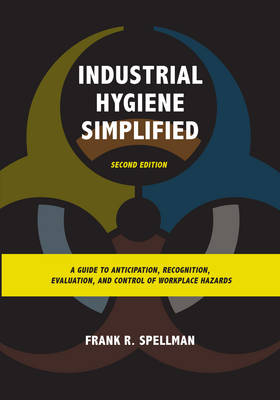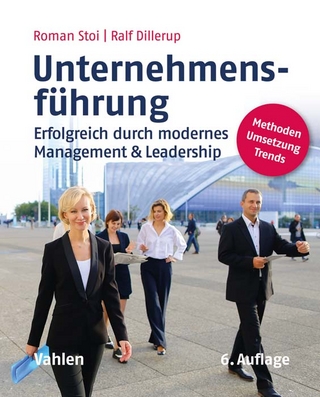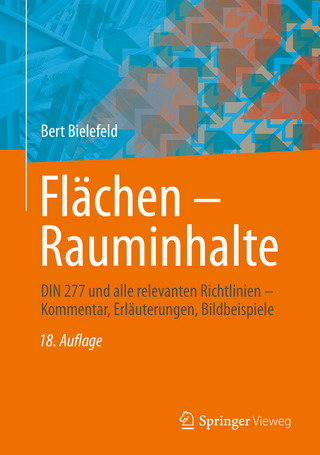
Industrial Hygiene Simplified
Bernan Press (Verlag)
978-1-59888-962-8 (ISBN)
Recognized as an authoritative treatment of an important subject area, and presented in a conversational and straightforward style, Industrial Hygiene Simplified, Second Edition is an updated edition of the original, well-received textbook. Industrial Hygiene Simplified is valuable and accessible for use by those involved in such disciplines as industrial technology, manufacturing technology, industrial engineering technology, occupational safety, management, and supervision. This book is ideal for those needing a refresh on industrial hygiene concepts and practices they may not use regularly, as well as those practitioners preparing for the Certified Industry Hygiene (CIH) exam.
Because it is a dynamic discipline, there is no question about the field of industrial hygiene having undergone significant change over the past four decades. Some of the reasons for this change include technological innovations that have introduced new hazards in the workplace, increased pressure from regulatory agencies, realization by industrial executives that a safe and healthy workplace is typically a more productive and litigious-free workplace, skyrocketing health care and worker’s compensation costs, and increased pressure from environmental groups and the public.
These factors have created a need for an up-to-date and user-friendly book in industrial hygiene that contains the latest information for those who practice this profession in the age of high technology and escalating on-the-job injuries with accompanying increased health care costs.
New features in the second edition of Industrial Hygiene Simplified include:
·Presentation in lesson format
·End-of-chapter review questions
·"Did You Know" pertinent facts
·Applicable and important math operations
Frank R. Spellman, PhD, is a retired assistant professor of environmental health at Old Dominion University, Norfolk, Virginia, and the author of more than 100 books covering topics ranging from concentrated animal feeding operations (CAFOs) to all areas of environmental science and occupational health. Many of his texts are readily available online, and several have been adopted for classroom use at major universities throughout the United States, Canada, Europe, and Russia; two have been translated into Spanish for South American markets He holds a BA in public administration, a BS in business management, an MBA, and an MS and PhD in environmental engineering.
Occupational Safety and Health Simplified for the Industrial Workplace
Frank R. Spellman
TABLE OF CONTENTS
Introduction
Chapter 1Occupational Safety and Health Practice
The Occupational Safety and Health Professional
Major Accident and Disasters
Regulatory Influence
Occupational Safety and Health Act (OSH Act) of 1970
OSHA Standards
General Duty Clause of the OSH Act
Final Note on Standards, Regulations, Laws, and Rules
The Organization's Safety Policy—The Ticket to Ride
Workplace Safety and Health Provisions: The Legal Ramifications
Case Study 1.1: A Stitch in Time
Employee Training
Contractor Training
The Host-Contractor Safety Interface
Case Study 1.2
The Bottom Line on Occupational Safety and Health in Industry
Signal Words
References and Recommended Reading
Chapter 2Safety and Health Terminology and Hispanic Outreach
Safety and Health Terminology
Defining Accident
Terminology
Hispanic Outreach
Hispanic Outreach Tools
English To Spanish OSHA Dictionary
Reference and Recommended Reading
Chapter 3Regulatory Requirements
That Knock at the Door
We Love to Hate Rules and Regulations
Workers' Compensation
Workers' Compensation Fraud
Title 29
OSH Act Enforcement
References and Recommended Reading
Chapter 4 Occupational Safety and Health Management
Management Aspects of Hazard Avoidance
The Right Way
Hazard Avoidance Concepts
Enforcement Approach
Psychological Approach
Engineering Approach
Analytical Approach
Hazard Analysis
Hazard Assessment
Accident Investigation
The Accident Investigation Process
Statistics
Behavior-Based Models
Benchmarking
Benchmarking: The Process
Total Quality Management (TQM)
The Bottom Line
References and Recommended Reading
Chapter 5Industrial Hygiene Concepts; Including Ventilation and Noise Controls
Industrial Hygiene
Workplace Stressors
Industrial Toxicology
Industrial Health Hazards
Control Methods
Engineering Controls
Ventilation
Concepts of Ventilation
Local Exhaust Ventilation
General and Dilution Ventilation
Industrial Noise Control
Determining Workplace Noise Levels
Engineering Controls for Industrial Noise
Industrial Vibration Control
Administrative Controls
Personal Protective Equipment (PPE)
References and Recommended Reading
Chapter 6Worker Right-To-Know
A Failure to Communicate
Better Communication with GHS for Worker Safety and Health
Phase-In Period for the Hazard Communication Standard
Major Changes to the Hazard Communication Standard
Classification
Label Changes Under the Revised HCS
SDS Changes under the Revised HCS
HazCom and the Occupational Safety and Health Professional
Definition of HazCom Terms
HazCom Audit Items
References and Recommended Reading
Chapter 7Emergency Response and Process Safety
OSHA and Emergency Response
Emergency Response Plan
Typical Contents of an Emergency Response Plan
Process Safety Management and Risk Management Planning
Process Safety Management (PSM)
PSM Definitions
How the Standard Works; Its Application
Specific PSM Requirements
A Final Word on PSM
Risk Management Planning
Hazard Assessment
Prevention Program
Response Program
RMP Definitions and Requirements
RMP Program Levels
RMP and PSM: The Similarities
RMP and PSM: The Differences
Summary of RMP Requirements
The Bottom Line
References and Recommended Reading
Chapter 8Industrial Facility Design
The Safe and Healthy Workplace
Codes and Standards
Plant Layout
Illumination
High Hazard Potential Work Areas
Load-Bearing Components
Beams
Floors
Columns
Ladders
Personal and Sanitation Facilities
Emergency Eyewash/Showers
Industrial Workplace Safety and Health Checklist
References and Recommended Reading
Chapter 9Ergonomics and Manual Lifting
Elements of an Ergonomics Program
Hazard Identification, Prevention, and Control
Management Commitment and Employee Participation
Medical Management
Program Evaluation
Training
Back Injury Prevention
Causes of Back Injuries
Controlling On-The-Job Back Injuries
Biomechanical Approaches
Physiological and Psychological Approaches
Prevention
Administrative Controls
Engineering Controls
When to Employ Administrative and Engineering Controls
Lower Back Pain and Standing
Final Thoughts
References and Recommended Reading
Chapter 10Toxic Substances and Hazardous Wastes
Fundamental Toxicology for the Industrial Workplace
The Chemical World We Live In
Sick Water
Toxicology and Risk
Toxicological Terms
Other Pertinent Toxicological Definitions
Classification of Toxic Agents
Significant Chemical and Biological Toxins and Effects
Factors Affecting Toxicity
Classification of Toxic Materials
Target Systems/Organs Commonly Affected by Toxins
Carcinogens, Mutagens, and Teratogens
Risk Assessment
What Is Risk?
Hazardous Waste Handling
America: A Throwaway Society
What is a Hazardous Substance?
Hazardous Material
Hazardous Substances
Extremely Hazardous Substances
Toxic Chemicals
Hazardous Chemicals
Hazardous Wastes
EPA-Listed Hazardous Wastes
Where Do Hazardous Wastes Come From?
Hazardous Waste Legislation
Resource Conservation and Recovery Act
CERCLA
OSHA’s Hazardous Waste Standard
Hazardous Waste Safety Program
References and Recommended Reading
Chapter 11Noise Control
OSHA's Hearing Conservation Requirements
Occupational Noise Exposure
Hearing Conservation: The Written Program
Monitoring: Sound Level Survey
Audiometric Testing
Hearing Protection
Training
Safe Work Practices
Recordkeeping
Administrative and Engineering Controls
References and Recommended Reading
Chapter 12Fire, Welding, and Hot Work Safety
Fire Safety
OSHA and Fire Safety
Fire Prevention and Control
Fire Protection Using Fire Extinguishers
Flammable and Combustible Liquids
Welding Safety Programs
General Welding Safety
Fire Prevention and Protection: Welding Safety Program Elements
Managers and Supervisors
Personal Protective Equipment (PPE) and Other Protection
Railing and Welding Cable
Eye Protection
Protective Clothing
Confined Spaces
Ventilation and Health Protection
Arc Welding Safety
Safe Work Practice: Arc Welding
Gas Welding and Cutting Safety
Safe Work Practice: Gas Welding and Cutting
Cutting Safety
Hot Work Permit Procedure
Fire Watch Requirements
References and Recommended Reading
Chapter 13 PPE, First Aid, and Thermal Hazards
Personal Protective Equipment (PPE)
Case Study 13.1
OSHA's PPE Standard
OSHA's PPE Requirements
Hazard Assessment and PPE
PPE Training Requirement
Respiratory Protection
Respirators Defined
Respiratory Protection Program
Responsibilities
Definition of Terms
Types of Respirators
Chemical Cartridge Respirators
Airline Respirators (Helmets, Hoods, and Masks), Cascade-fed, or Compressor-fed
Self-contained Breathing Apparatus (SCBA)
Respirator Selection and Distribution Procedures
Respirator Inspection, Maintenance, Cleaning, and Storage
Inspection
Maintenance
Cleaning
Storage
Respirator Fit-Testing
Medical Surveillance
Training
Documentation Procedures
Respirator Program Evaluation
First Aid in the Workplace
Thermal Hazards
Thermal Comfort
The Body's Response to Heat
Heat Definitions
Heat Disorders and Health Effects
Heat Stroke
Heat Exhaustion
Heat Cramps
Heat Flashes
Heat Fatigue
Cold Hazards
References and Recommended Reading
Chapter 14Confined Space Entry
OSHA's Confined Space Entry Program
Confined Space Entry: Definitions
Evaluating the Workplace
The Permit-Required Confined Space Written Program
Permit-Required Confined Space Entry: Equipment
Testing and Monitoring Equipment
Ventilating Equipment
Personal Protective Equipment (PPE)
Lighting
Barriers and Shields
Ingress and Egress Equipment: Ladders
Rescue Equipment
Other Equipment
Pre-Entry Requirements
Permit System
Permit Requirements
Confined Space Training
Training Requirement for Confined Space Entry
Workplace Confined Space Training Program
Confined Space Certification Exam
Assignment of On-Site Personnel
Duties of Authorized Entrants
Duties of the Attendant
Duties of Entry Supervisors
Confined Space Rescue
Rescue Services
Rescue Service Provided by Outside Contractors
Non-Entry Rescue
Alternative Protection Methods
Hierarchy of Permit-Required Confined Space Entry
Procedures for Atmospheric Testing
Testing Procedures
Air Monitoring and OSHA
Other OSHA Permit-Required Confined Space Audit Items
References and Recommended Reading
Chapter 15Lockout/Tagout
OSHA's Lockout/Tagout
Lockout/Tagout Key Definitions
Lockout/Tagout Procedure (A Sample)
Special Conditions: Logout/Tagout Removal when Authorized Employee Is Absent
Methods of Informing Outside Contractors of Procedures
References and Recommended Reading
Chapter 16Electrical Safety
Control of Electrical Hazards
Grounding and Bonding
Grounding and Bonding Requirements
Summary of Safety Precautions for Electrical Circuits
References and Recommended Reading
Chapter 17Fall Protection
Fall Protection: Defining the Problem
Physical Factors at Work in a Fall
Slips: Falls on the Same Level
Trips: Falls on the same Level
Stair Falls: Falls on One of More Levels
Elevated Falls: Falls from One Level to Another
Fall Protection Measures
Fall Protection Policy
References and Recommended Reading
Chapter 18Pressure Vessel Safety
High Pressure or Low Pressure: Just as Deadly
What Is a Pressure Vessel?
OSHA Requirements
Pressure Definitions
Pressure Vessel Safety Program
Controls
Written Safe Work Practices
Training
Proof Testing
Pressure Relief Systems
Required Inspections
Pressure Vessel Safety Factor/Margin
References and Recommended Reading
Chapter 19Rigging and Material Handling Safety
Rigging Safety
Written Rigging Safety Program
Fundamental Engineering Concepts for Rigging
Resolution of Forces
Slings
Rated Sling Loads
Inclined Plane
Safety: Ropes, Slings, Chains
Rigging Equipment and Attachment: General
Rope Slings
Wire Rope
Chains and Chain Slings
Training
Proof Testing Rigging Equipment
Inspections
Safe Work Practices
References and Recommended Reading
Chapter 20Radiation Safety
Radiation Safety in the Workplace
Complying with OSHA's Radiation Safety Requirements
Controls
Training
References and Recommended Reading
Chapter 21Machine Guarding
Purpose of Machine Guarding
Basics of Safeguarding Machines
Safeguarding Defined
Types of Machine Safeguards Required
Mechanical Hazards: Motions and Actions
Common Safeguarding Methods
Guards
Devices
Feeding and Ejection Methods
Safeguarding by Location/Distance
Miscellaneous Safeguarding Accessories
Safe Work Practices
Safe Work Practices: Machine Guarding
Training, Enforcement, and Inspections
Machine Hazard Warnings
Employee Clothing and Jewelry
Lockout/Tagout
References and Recommended Reading
Chapter 22Worksite Security
Safety and Upgrading Security
What Not to Do: Judge by Appearances
What to Do: The Threat Assessment Team
Hazard Assessment
Workplace Security Analysis
Workplace Survey
What to Implement: Hazard Control and Prevention
Buildings, Workstations, and Areas
Security Equipment
Work Practice Controls and Procedures
Don't Be A Stranger
Checklist Questions for Industrial Facilities
Is Your Current System Adequate?
Security and the Industrial Setting
What Does Facility and Security Entail?
Good Fences Makes Good Neighbors
Protection from Theft
Protection of Equipment and Data
Protection from Harm
References and Recommended Reading
Chapter 23 Violence in the Industrial Workplace
Media-Intensive Events
Case Study 23.1: An Obsession with Linda
What is Workplace Violence?
Why Does Workplace Violence Occur?
What to Do
Reporting Workplace Violence
Preventing Potential Problems
Conflict Resolution
Early Warning Signals
Protecting Personnel: Control for Workplace Violence
Is Your Facility Safe and Secure?
Recommended Personal Safe Work Practices for External Violence
References and Recommended Reading
Chapter 24Record keeping
Too Many Is not Always Enough
OSHA-200/300 Log
Training and Inspection Records
Medical Records and Other OSHA-Required Records
The Bottom Line
References and Recommended Reading
Appendix: Sample Confined Space Certification Exam
| Erscheinungsdatum | 01.02.2018 |
|---|---|
| Verlagsort | Lanham |
| Sprache | englisch |
| Maße | 176 x 253 mm |
| Gewicht | 839 g |
| Themenwelt | Wirtschaft ► Betriebswirtschaft / Management ► Unternehmensführung / Management |
| ISBN-10 | 1-59888-962-1 / 1598889621 |
| ISBN-13 | 978-1-59888-962-8 / 9781598889628 |
| Zustand | Neuware |
| Haben Sie eine Frage zum Produkt? |
aus dem Bereich


